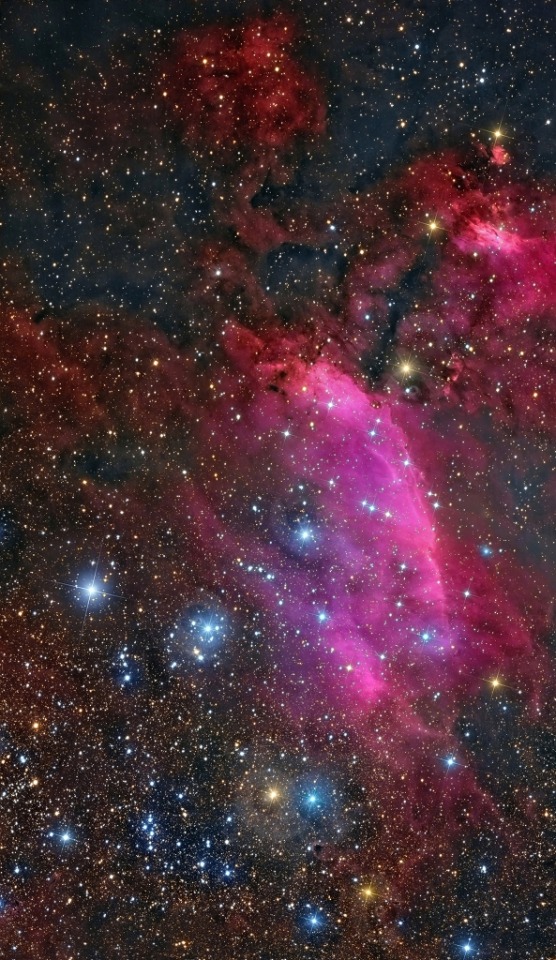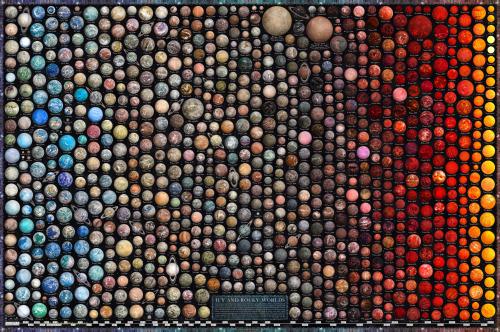IC 4628: The Prawn Nebula ©

IC 4628: The Prawn Nebula ©
More Posts from Ad-astra-affecte-spe and Others

Bioluminescence and Milky Way



The Rosetta Nebula and NGC 2244
At the heart of the Rosetta nebula is an open cluster of stars, which is NGC 2244. The entire structure sits at the end of a giant molecular cloud, and you can easily spot the tell tale columns and protostars at the head showing active star formation on-going.
The bottom image is from Chandra, which gives the purple/pink colours for X-Ray sources, used particularly in spotting black hole accretion disks, pulsars and supernova remnants, we can see it's a lively place !
The entire structure is in the constellation of Monoceros at around 5,200 light years from Earth.

2023 February 25
Crescent Moon Occultation Image Credit & Copyright: Fefo Bouvier
Explanation: On February 22, a young Moon shared the western sky at sunset with bright planets Venus and Jupiter along the ecliptic plane. The beautiful celestial conjunction was visible around planet Earth. But from some locations Jupiter hid for a while, occulted by the crescent lunar disk. The Solar System’s ruling gas giant was captured here just before it disappeared behind the the Moon’s dark edge, seen over the RÃo de la Plata at Colonia del Sacramento, Uruguay. In the serene river and skyscape Venus is not so shy, shining brightly closer to the horizon through the fading twilight. Next week Venus and Jupiter will appear even closer in your evening sky.
∞ Source: apod.nasa.gov/apod/ap230225.html

Sagittarius dwarf irregular galaxy (sagDIG) © Hubble

For ten years the stargazer dreamed of taking a picture like this. The dreamer knew that the White Desert National Park in Egypt's Western Desert is a picturesque place hosting numerous chalk formations sculpted into surreal structures by a sandy wind. The dreamer knew that the sky above could be impressively dark on a clear moonless night, showing highlights such as the central band of our Milky Way Galaxy in impressive color and detail. So the dreamer invited an even more experienced astrophotographer to spend three weeks together in the desert and plan the composite images that needed to be taken and processed to create the dream image. Over three days in mid-March, the base images were taken, all with the same camera and from the same location. The impressive result is featured here, with the dreamer -- proudly wearing a traditional Bedouin galabyia -- pictured in the foreground.


With giant storms, powerful winds, auroras, and extreme temperature and pressure conditions, Jupiter has a lot going on. Now, NASA’s James Webb Space Telescope has captured new images of the planet. Webb’s Jupiter observations will give scientists even more clues to Jupiter’s inner life.
Credit: NASA, ESA, CSA, Jupiter ERS Team; image processing by Judy Schmidt. Read more

NASA's Juno spacecraft captured this look of high altitude haze forming above cyclones. At the time the image was taken, Juno was about 5,095 miles above Jupiter’s cloud tops 🛰

L1527 IRS - Protostar
Stars form when bodies of dust and gas create enough mass to create a gravitational effect that's able to then pull in more gas, the process continues and the mass increases until the pressure at the centre is sufficient for fusion to begin.
There's many examples of protostars, in fact back in 2012, NASA’s Spitzer Space Telescope focused in on L1527 IRS, believed at the time to be the youngest forming star ever found.

Recently, the JWST re-visited this protostar, and the title image was the result.
The forming star cannot be visually spotted, but is thought to be around 20-40% the mass of our own Sun already.

If you look closely, you can see there's a dark patch in the centre, this is actually the accretion disk around the newly formed star, what is left over after the formation, may go on to form the planets, in fact, they may be actually starting to be created already, as recent evidence does point to planets being born around the same time as the star does in many cases.
The protostar is only 450 light years from Earth in the Constellation of Taurus, and is thought to be around 100,000 years old, a blink of an eye in the life of a star, particularly of this mass.

Over 800 terrestrial exoplanets visualized and arranged according to their equilibrium temperature and size.
chart by u/mVargic
-
 theblondprincess reblogged this · 1 year ago
theblondprincess reblogged this · 1 year ago -
 matureguyfromoz reblogged this · 1 year ago
matureguyfromoz reblogged this · 1 year ago -
 lovealwaysandforevermore reblogged this · 1 year ago
lovealwaysandforevermore reblogged this · 1 year ago -
 lovemusicnart reblogged this · 1 year ago
lovemusicnart reblogged this · 1 year ago -
 the77snk reblogged this · 1 year ago
the77snk reblogged this · 1 year ago -
 lovemusicnart liked this · 1 year ago
lovemusicnart liked this · 1 year ago -
 astat3ofgrac3 reblogged this · 1 year ago
astat3ofgrac3 reblogged this · 1 year ago -
 jparkinlit liked this · 1 year ago
jparkinlit liked this · 1 year ago -
 skarlettriott reblogged this · 1 year ago
skarlettriott reblogged this · 1 year ago -
 recklessandrelentless reblogged this · 1 year ago
recklessandrelentless reblogged this · 1 year ago -
 woooow01 liked this · 1 year ago
woooow01 liked this · 1 year ago -
 onefrostbitcanadian liked this · 1 year ago
onefrostbitcanadian liked this · 1 year ago -
 onefrostbitcanadian reblogged this · 1 year ago
onefrostbitcanadian reblogged this · 1 year ago -
 jackatlas reblogged this · 1 year ago
jackatlas reblogged this · 1 year ago -
 alieba reblogged this · 1 year ago
alieba reblogged this · 1 year ago -
 losusdesperatus reblogged this · 1 year ago
losusdesperatus reblogged this · 1 year ago -
 sheliesshattered reblogged this · 1 year ago
sheliesshattered reblogged this · 1 year ago -
 zombiscribe reblogged this · 1 year ago
zombiscribe reblogged this · 1 year ago -
 snarkymonkeyprime reblogged this · 1 year ago
snarkymonkeyprime reblogged this · 1 year ago -
 loui-se09 liked this · 1 year ago
loui-se09 liked this · 1 year ago -
 freshfrenchangel liked this · 1 year ago
freshfrenchangel liked this · 1 year ago -
 cdnbadlands reblogged this · 1 year ago
cdnbadlands reblogged this · 1 year ago -
 cdnbadlands liked this · 1 year ago
cdnbadlands liked this · 1 year ago -
 maybeamalbec reblogged this · 1 year ago
maybeamalbec reblogged this · 1 year ago -
 maybeamalbec liked this · 1 year ago
maybeamalbec liked this · 1 year ago -
 reality-rogue reblogged this · 1 year ago
reality-rogue reblogged this · 1 year ago -
 loveherallican-blog liked this · 1 year ago
loveherallican-blog liked this · 1 year ago -
 un-r-wuenscht reblogged this · 1 year ago
un-r-wuenscht reblogged this · 1 year ago -
 anynameisbetterthanmyfirstone liked this · 1 year ago
anynameisbetterthanmyfirstone liked this · 1 year ago -
 david-watts reblogged this · 1 year ago
david-watts reblogged this · 1 year ago -
 dicktrayce69 liked this · 1 year ago
dicktrayce69 liked this · 1 year ago -
 david-watts reblogged this · 1 year ago
david-watts reblogged this · 1 year ago -
 dangerouslymassivenacho reblogged this · 1 year ago
dangerouslymassivenacho reblogged this · 1 year ago -
 david-watts reblogged this · 1 year ago
david-watts reblogged this · 1 year ago -
 galaxybun7 liked this · 1 year ago
galaxybun7 liked this · 1 year ago -
 davland09 liked this · 1 year ago
davland09 liked this · 1 year ago -
 twilightangel004 liked this · 1 year ago
twilightangel004 liked this · 1 year ago -
 darkerthan-demons liked this · 1 year ago
darkerthan-demons liked this · 1 year ago -
 crazypaine liked this · 1 year ago
crazypaine liked this · 1 year ago -
 exspressso liked this · 1 year ago
exspressso liked this · 1 year ago -
 maxsyms reblogged this · 1 year ago
maxsyms reblogged this · 1 year ago -
 maxsyms liked this · 1 year ago
maxsyms liked this · 1 year ago -
 heavenly-garden reblogged this · 1 year ago
heavenly-garden reblogged this · 1 year ago -
 heavenly-garden liked this · 1 year ago
heavenly-garden liked this · 1 year ago

★•Astronomy, Physics, and Aerospace•★ Original and Reblogged Content curated by a NASA Solar System Ambassador
204 posts
